In this second of a series of articles, Adam Walker dissects the Ocean Walker Technique and provide you with crucial tips in order to swim fast, efficient and injury free for pool and open water swims. This time he focuses on the importance of the position of your elbows.
One of the biggest life changing moments was when I changed my front crawl stroke from over-head arm rotation to a semi-circle elbow push. Allowing a relaxed forearm and hand to be led by the elbow. This result in the lats and shoulder joint going outwards, not inwards ensuring the shoulder socket is protected and not placed in a vulnerable position.
I wouldn’t have been able to continue swimming, let alone complete the ‘Oceans Seven’ without changing this part of the stroke. It saved me and why many of you have experienced my great passion for it at my swim camps. It has without question been life changing for me!
The principle
As with most swimmers, the aim is to get the hand in first followed by the arm into the water. Next is finding the catch efficiently (which comes after maximising a glide created from hip rotation) in order to pull water back to move you forwards. What your arm does on its way there and just afterwards is just as important in order to prevent injury and imbalance and shouldn’t be overlooked.
So why?

The majority of swimmers shoulder issues according to medical specialists are caused from overhead rotation creating instability, rotator cuff, tendonitis, impingement and other shoulder related injuries. By creating a low semi-circle ‘elbow push’ instead of an over arm forearm lift, instantly takes pressure off the shoulder joint by working within the shoulders natural range and avoid rubbing of tendons.
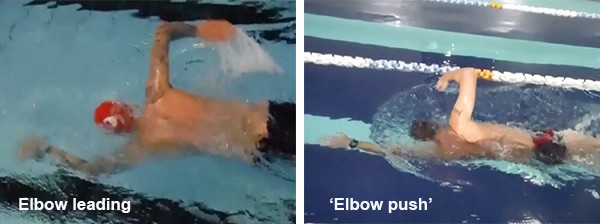
Now I can hear you say, ‘Throwing my arm overhead was how I was taught to swim.’ Well, me too, I was also taught the same way and I actually coached this way for over 15 years, it wasn’t until I was forced to change due to injury I started analysing in-depth the movement from a biomechanical perspective. It was then approved from a medical perspective.
This is backed up by a comment from David Pickering, Registered Osteopath and Acupuncturist at Hull Osteopaths, who commenting on overhead arm strokes said:
“The muscles of the shoulder is placed into a repeatedly vulnerable position, where they are brought into close contact with the bony structures of the shoulder girdle. Knowing this, it may not surprise you that, according to various research papers, between 40 and 91% of swimmers over the duration of their careers will suffer a swimming-related shoulder injury. This is a rather alarming rate of injury, I'm sure you'll agree, especially for a sport which is considered to be low-risk for injuries.’”
How?
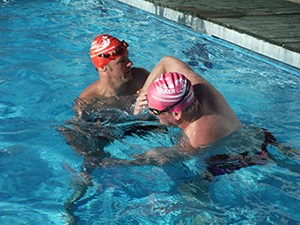
In order to practice and to imprint the muscle memory, the ‘elbow push’ is low enough to drag finger nails across the top of the water ensuring no overarm lifting. When the shape has become fully imprinted, then the ‘elbow push’ is high enough to avoid the top of the water by 1-2 inches.
Further benefits
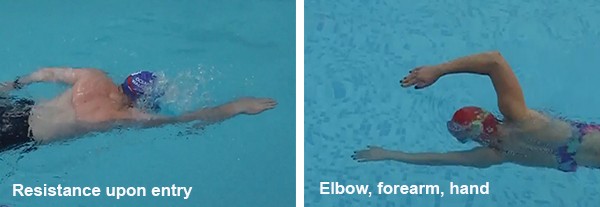
Having an elevated elbow higher than the forearm and hand provides the ability for a clean hand entry as long as you keep it higher throughout entry and submersion. By keeping this angle avoids unnecessary resistance from the elbow collapsing and hitting the water either before or at the same time the hand enters, which I refer to as an ‘armpit fart’.
Beware forcing a high elbow!
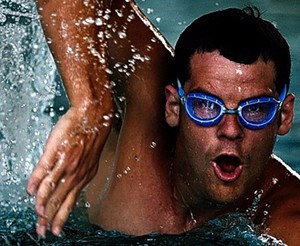
With a flat body position in order to obtain a high elbow requires the forearm and elbow having to be lifted and driving the shoulder socket up towards the shoulder girdle which causes stress and tension thus creating potential for impingement and common injury amongst swimmers.
My elevated high elbow position does not come from driving the shoulder socket up towards the shoulder girdle. My arm is relaxed as a result of being on my side and with a 40 degree depth under water with my front arm, the downward position, creates a natural elevated position within the body’s range of movement. If my front arm was more towards the surface of the water, it would require the elbow to be potentially lifted. However, this is not the case with the front downward position I find myself in. Also at the point of entry the hips allow the front arms to drop into the water effortlessly without any forward driving or punching.
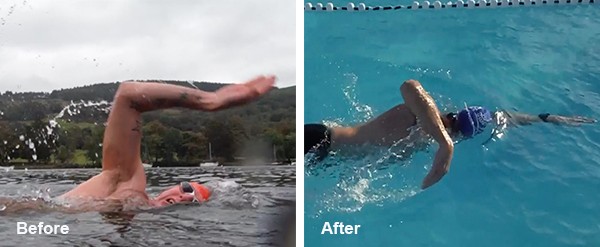
The Result: Effortless arm approach and effortless entry, limiting drag, muscle use and therefore saving energy as well as significantly reducing the potential for injury!
How we position one part of the body in water has a knock on effect to the rest of the body. As water supports us, we don’t realise or often feel what we are doing. This is why, when I am coaching the Ocean Walker Technique, I break down the individual stages and explain in-depth why you are positioning yourself in a certain way. Once you are aware of your body and what it is doing you have the power to make the necessary changes to improve.
Freestyle Swimming Technique - Avoid Arm Driving For Improved Efficiency -->














